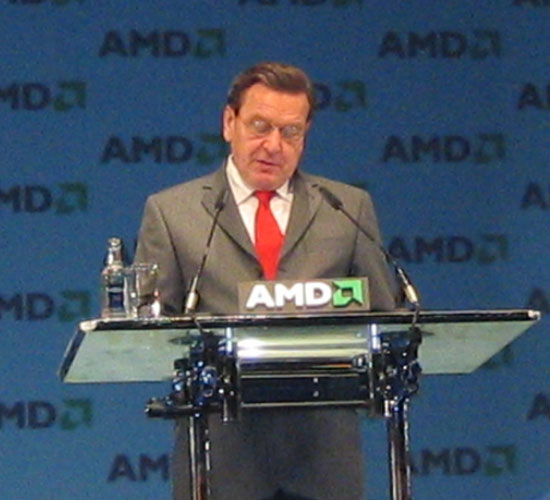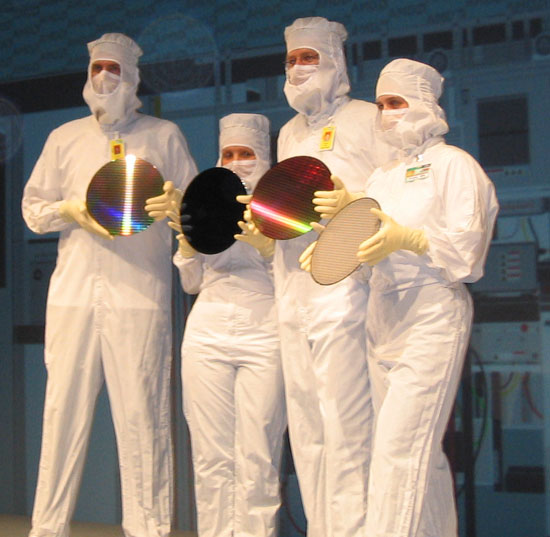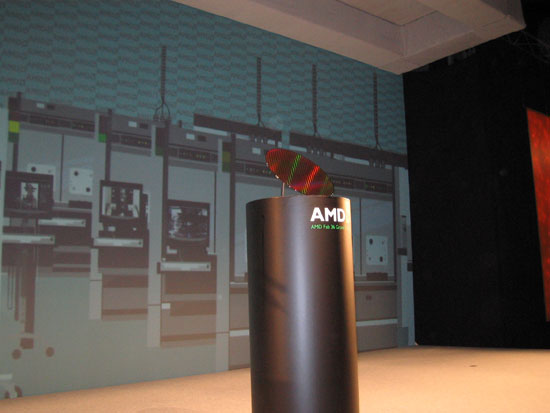AMD's Fab 36 Grand Opening - 90nm and 300mm in Germany
by Anand Lal Shimpi on October 14, 2005 7:50 AM EST- Posted in
- CPUs
AMD Draws a Crowd: German Chancellor Schröder Arrives
After the initial press conference we took a short bus ride to an outside tent where both Dr. Deppe and Dr. Ruiz gave a few words about Dresden and Fab 36, before handing the mic off to German Chancellor Gerhard Schröder.
One point to note was the constant mentioning of "fair competition" in all of Dr. Ruiz speeches, obviously referring to AMD's recent lawsuit against Intel. Dr. Ruiz also mentioned AMD's 50-by-15 goal; that by 2015, 50% of the world will be "connected", partially in thanks to an increase in production of AMD's products. Intel has also outlined their plans for 2015, which we've covered in the past.

German Chancellor Gerhard Schröder
Chancellor Schröder also made it a point to mention the importance of such a large investment in Dresden, being a part of former East Germany, while stressing that the incoming German government should make it a point to encourage similar investments in the future.
Chancellor Schröder also briefly touched on the topic of fair competition and how Germany's cooperation with AMD has been in the spirit of fair competition, also clearly in reference to AMD's recent lawsuit.

Governer of Saxony, Professor Dr. Georg Milbradt
Dresden is located in the German state of Saxony, and next up was the Governer of the State of Saxony, Professor Dr. Georg Milbradt. Professor Milbradt spoke of the history of Saxony from its humble beginnings to being a center for semiconductor manufacturing thanks to companies like AMD and Siemens.
Professor Milbradt's speech also took a political tone, as he stressed the importance of the new federal government to do even more to encourage investments such as AMD's in Dresden. He stressed that the investments are necessary in order to make Saxony and Dresden competitive in the EU and in the world.
Both Milbradt and Schröder hinted that AMD should definitely consider Dresden for their next fab plant, which Dr. Ruiz mentioned could potentially begin construction as early as 2008.

More 300mm wafers, we counted at least 5 today, that should be enough for at least a few Athlon 64 X2s.
The speeches were concluded with a ceremonial "raising of the wafer" as a 300mm wafer rose from the stage and was presented to Dresden, the state of Saxony and Dresden.

The events at Fab 36 in Dresden are just beginning, we're about to head to a Q&A session followed by some technical tracks and tours of the new plant.
AMD is hopefully going to present us with their future plans later today, which we've been looking forward to ever since Intel's IDF announcements. We'll see if AMD can deliver a more interesting look at their future than the ambiguity that we've been given in the past; stay tuned.










70 Comments
View All Comments
ceefka - Friday, October 14, 2005 - link
50%? That will take a long time still, if ever. I suppose Intel will have done something significant or a lot of significant stuff before that or they're toast.matthewfoley - Friday, October 14, 2005 - link
In this case, because AMD is the underdog with the cheaper chips almost across the board, then if they claim more of the market, prices will go down, which should be better for all of us.IdahoB - Friday, October 14, 2005 - link
"While we don't have a 200mm wafer here to compare sizes with, imagine the wafer pictured above, but smaller."Outstanding :)
johnsonx - Friday, October 14, 2005 - link
got a big LOL out of that one myself... came into the comments just to comment on it.nserra - Friday, October 14, 2005 - link
I really laugh at that too ;)Lord Zado - Friday, October 14, 2005 - link
Save picture, go to photo editing program of choice, scale by 66.67% and viola! A 200mm wafer :)Diasper - Friday, October 14, 2005 - link
That's really disappointing and does indicate that AMD *is* significantly behind. My hope was for early 65nm production for AMD to increase profits but more importantly get 65nm chips out to us - which given trying to manufacture in bulk would mean 65nm chips for S939 of at least dual-core.
Any idea when Intel is meant to swing into 'full' 65nm production? Early 2006?
Viditor - Friday, October 14, 2005 - link
No, it really doesn't. Guys, think about it and remember back when 90nm was introduced first by Intel.
The fact then (and now) was that even at 130nm, AMD had superior chips compared to Intel's 90nm parts. For AMD to convert to 65nm parts now would mean they are just throwing their 90nm production lines in the garbage, when they are still churning out chips that will exceed Intel's 65nm parts! That would be a terrible waste and would increase the cost of the AMD chips significantly...and for what?
JarredWalton - Friday, October 14, 2005 - link
You can say all you want about K8 beating NetBurst, but Conroe/Merom/etc. are going to put up a hell of a fight. No one really knows yet (that can talk, at least) how the next gen Intel architecture performs. Do you really think Intel is planning on just matching K8, though?Part 2: AMD is really behind on manufacturing plants, but that comes from total revenues. AMD has only a few plants, and I think Fab 30 is the only 90nm plant. (I could be wrong - maybe they have two 90nm plants, not counting fab 36?) Meanwhile, Intel has something like 9 in full production of 90nm parts. Oh yeah, and this is AMD's first 300mm fab, where all of Intel's have been 300mm for... five years? More?
As I said, it comes down to revenues. 40 billion vs. 4 billion, isn't it? Or maybe 30 billion and 8 billion? The point is that Intel is making a lot more money, which allows them to build more fabs, which allows them to procure more OEM partners.... It's a viscious cycle (from AMD's perspective).
But hey, competition is good. Statements like "AMD is behind on manufacturing" are true, and sugar coating it doesn't do anyone any favors. That's the same as the "AMD had superior 130nm chips compared to Intel's 90nm parts." What are you trying to do, get a job with AMD? Was Barton better than Prescott? Not really. Is Newcastle better than Dothan? It depends on the market, and the mobile market has answered with an emphatic NO! Are Newcastle and Hammer better than Prescott, Irwindale, Sonoma, etc.? In many cases, yes. Too bad Intel makes and sells about 10X as many of those as AMD... which comes back to manufacturing. Long term, this plant opening should only be a good thing for AMD, but it's far too early to declare it a complete success.
Viditor - Friday, October 14, 2005 - link
Ummm...If no one really knows, how do you know that they are going to "put up one hell of a fight"? :)
I think they are planning on doing the very best that they can, as will AMD.
Intel's Nextgen does indeed sound good on paper, but so did Prescot. BTW, do you really think AMD is going to stop innovating between now and then as well?
Part2: AMD is only "behind" on the number of Fabs (the quality of their Fab30 is the best in the world, and they have all of the awards to prove it). If they had the same number of Fabs as Intel, they would be bankrupt tomorrow (or already) because:
1. They don't sell anywhere near the range of semiconductors that Intel does (not just CPUs), so those extra Fabs would be just sitting there.
2. AMD is still locked out of a lot of the market (vis a vis the antitrust action), so again those extra Fabs would be just sitting there.
3. For a list of Intel's Fabs, check http://www.intel.com/pressroom/kits/manufacturing/...">here.
Note that the majority are 130nm and 200mm...also note that very few of their Fabs (though it doesn't say this on the list) make CPUs.
I disagree. Quantity does not equate to better quality or even making more money. To give you an example, Intel uses a manufacturing method called "copy everything"...what this means is that they develop and tweak the chip on a pilot line, then copy all of the parameters to all of their Fabs that manufacture that part. This is a very smart thing to do if you have Fabs all over the place, but it makes future changes nearly impossible to accomplish quickly (because they have to first change the pilot Fab, then refit all of the rest of the Fabs.
OTOH, AMD has a dynamically changing model utilizing their proprietary APM software. They can even change a single wafer in the middle of processing it!
You should read http://tinyurl.com/b9llw">this article!
APM is (IMHO) the main reason AMD has done as well as they have been for the last few years...